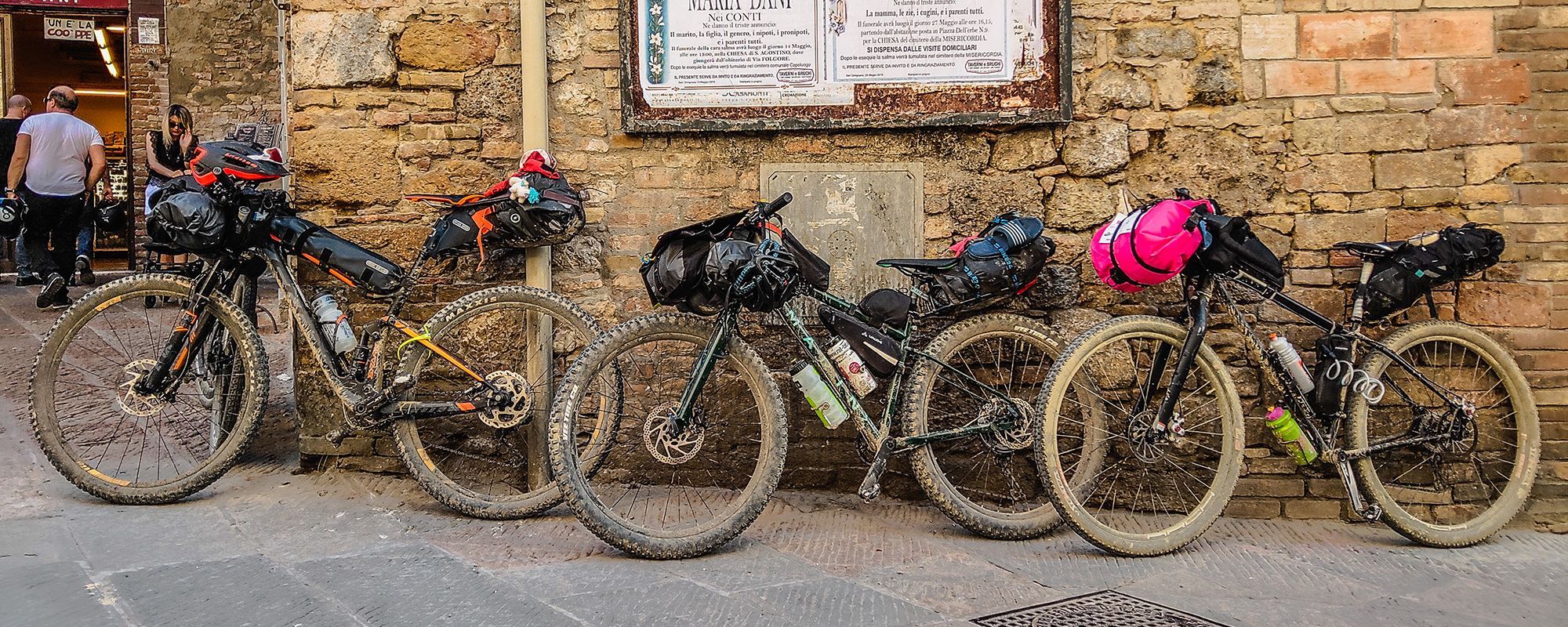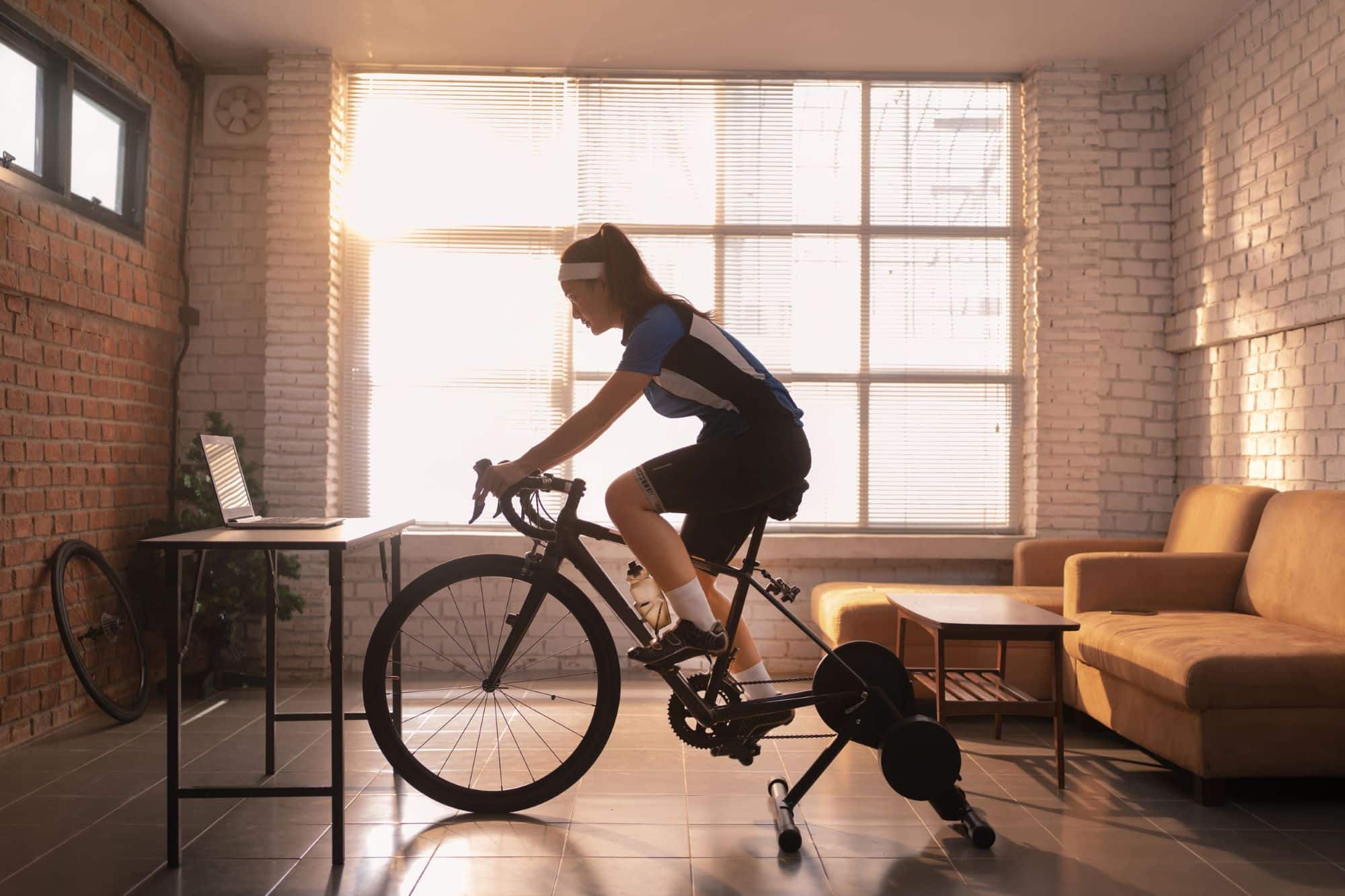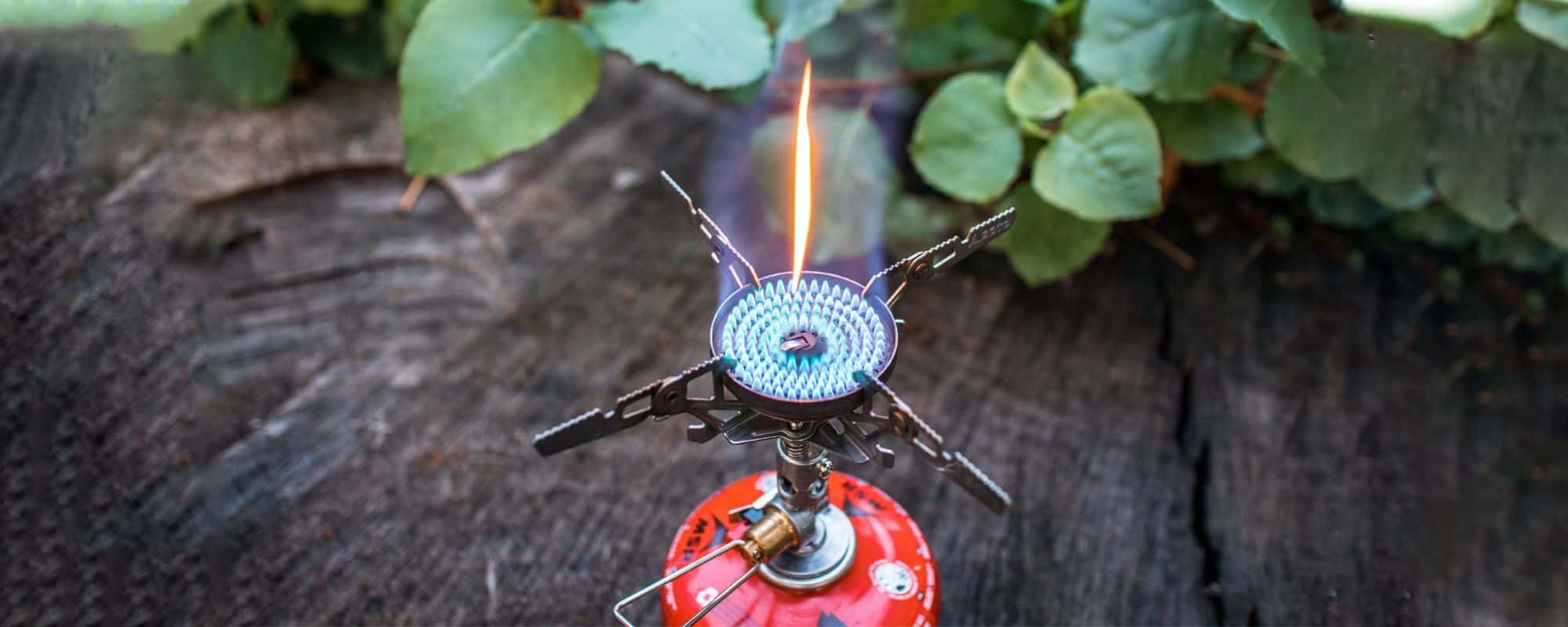What is the best tent for a bike trip and for bikepacking? There is currently a seemingly endless selection of tents on the market. That can be quite confusing! So there are now: Ultralight tents, freestanding tents, tents for 3 or 4 seasons and with or without awning. There are also single and double-walled tents. Some also come with footprints, some without, and certain ultralight tents also come without poles.
In this article you will find a detailed and understandable tent guide. In it you will probably learn everything there is to know about tents. I have written down the knowledge for you in a simple and understandable way.
You will also find an overview of recommended tents from the following categories:
✅ Bikepacking tent: Tents for minimalist bike travel. Here the focus is on low weight and a compact pack size
✅ Tent for bike trip and tent for bike tour: Are tents for (mostly) one or two people and are suitable for short or extended bike tours. The tents are robust, durable and offer comfortable space inside for people and equipment.
With the important topic of price, there are big differences: Premium tents like to cost several hundred euros. Fortunately, there are also very inexpensive TOP tents. For each tent category, I therefore show recommended price tips including their pros and cons. Plus, of course, we take a look at the most popular bikepacking tents and the absolute TOP tents in the tent for bike touring section.

You’re in a hurry? Tent recommendation: MSR Hubba NX
You’re in a hurry? The MSR Hubba NX has proven itself to many bike travelers over the years. It also meets all the above requirements. So my recommendation for the best bikepacking tent and tent for bike touring is the MSR Hubba NX in the green color.
- VienvietÄ— palapinÄ— MSR Hubba NX - Žalia
* Werbung - Aktualisierung am 2025-07-10, Preis kann gestiegen sein, Als Amazon-Partner verdiene ich an qualifizierten Verkäufen, Bild:Amazon
The MSR Hubba NX tent is available in different sizes:
- As a 1-person tent - tent for bikepackers (MSR Hubba NX)*.
- As a 2-person tent - tent for solo bike travelers (MSR Hubba Hubba NX)*.
- As a 3-person tent - Tent for bike travel as a couple (MSR Mutha Hubba NX)*.
I have owned the 1-person MSR Hubba NX myself for 3 years now and am absolutely satisfied with it. It offers the best overall package of small pack size, reliability and robustness and space inside: Even with my 1-person tent I have my 1.84 height enough space to lie stretched out and sit upright. I can still stow some luggage in the tent and the tent has a small vestibule in which two small bike bags and my shoes fit easily. It is also quick and easy to assemble and disassemble.
Some time ago I already created a detailed video test of the MSR Hubba NX:
I bought the tent in 2017 for the Tuscany Trail in Italy. A year later I had it with me on a bike trip from Stuttgart to Istanbul and it still looks like new.
The MSR Hubba NX still convinces me today and it is my current favourite tent. The 1 person version is ideal for me as a minimalist bike traveler or for bikepacking trips. You need more comfort? then the 2-person variant or the 3-person variant is better suited for you.
So the MSR Hubba NX has been convincing me in practice for years. The technical peculiarities are also convincing:
✅ Light weight: Weighs just 1330 grams
✅ small pack size: Ideal as a bikepacking tent. The 2- or 3-person version is suitable as a tent for bike trips
✅ Freestanding tent: So that fast and convenient to set up.
…and much more. I present the MSR Hubba NX in detail in the detailed MSR Hubba NX practical test (test & experiences).
MSR Hubba NX bei Amazon kaufen*
Now we continue with the ultimate tent selection >>

Determine the requirements for your tent
First, please answer the following question: What kind of bike trip or bikepacking adventure are you taking?
- Do you only need your tent for a few weeks a year for a summer adventure? Or do you want a super reliable tent for a cycling trip around the world?
- Are you travelling as a couple and need a lot of space or are you alone and like to travel minimalistically?
- Do you like to stay at campsites or do you prefer wild camping?
- Are you out in good weather in the summer? Or can it rain sometimes or do you even camp in winter?
So what are your requirements? It is now time to answer these questions.
Have you given it any thought? Super! It will then be much easier for you to find the right tent for you. Read on now
In the last few years, however, I have been watching the market trends at all times. In addition, I was and am on many continents of this world with bike and tent on the road. The following tips ha proven themselves:
- Best tent for bike trip and best tent for bike tour for one person: Free standing, double walled, 2 person tent for 3 seasons, weighs between 1.5 and 2.5 kilos and has an inconspicuous color such as green. Such a tent fits centrally on the luggage rack of a touring bike. The space inside is comfortable: there is enough room for the cyclist and most of the luggage.
- For a couple so two people: A 3-person tent with the same requirements as above.
- best bikepacking tent: For a solo bikepacker, the 1-person variety or alternatively a tarp or bivy sack is suitable.
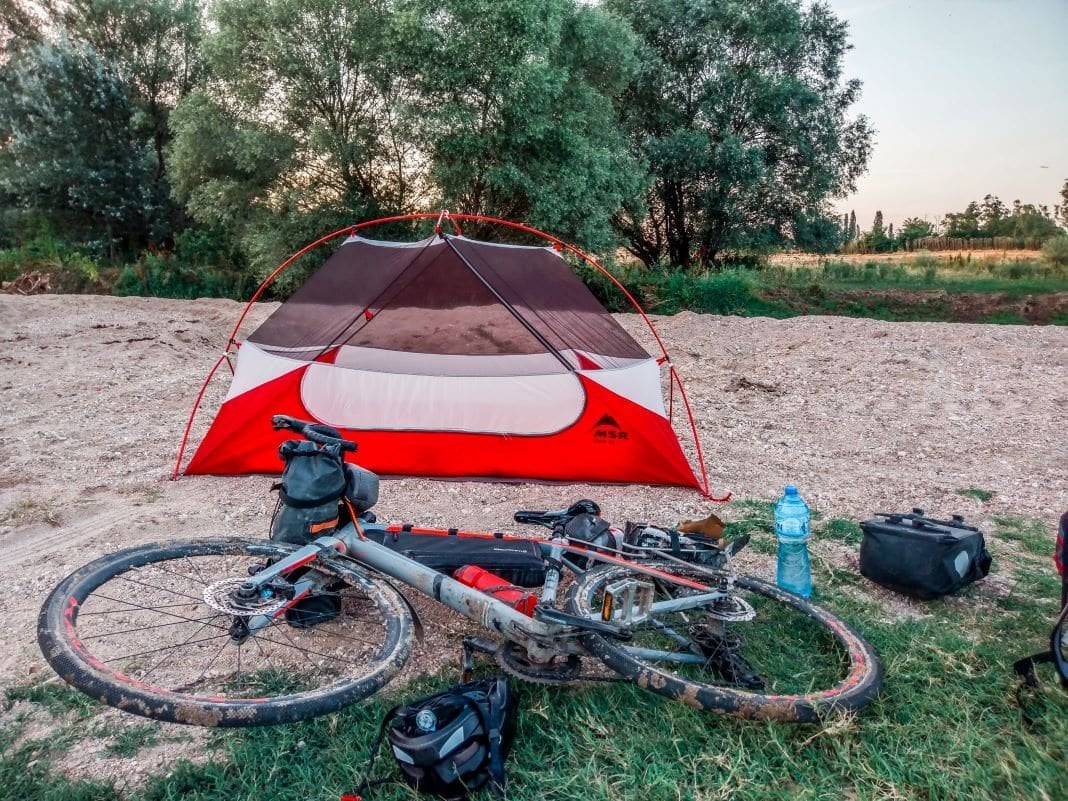
13 TOP tents for bikepacking and bike trips
So I’ve been doing a lot of research. Also, the list is based on my years of experience with different tents. In the process I found 10 tents that are very interesting. Also, I always keep the list up to date. The tents are suitable for bikepacking and also for normal bike trips and for a bike tour.
We start with cheap and simple tents. These are especially suitable for shorter trips and for bike tours in good weather. Then we work our way slowly. To tents that can withstand cycling trips across continents and are even suitable for a cycling world tour. These tents are therefore also suitable for cycling trips lasting several months or years. The list also includes recommended bikepacking tents. These are particularly light and have a small pack size. This means that they can be stowed directly in the frame bag or in the handlebar roller.
For all recommended tents I have also linked you directly to an online shop. This means you can order tents online immediately and have them conveniently delivered to your home.
You miss a tent or have an insider tip? Then feel free to drop me a comment.
Tent for bike trip and tent for bike tour – the TOP 5
The tents in this selection offer a particularly good mix of weight, space and price. These tents are also about weight. However, particular emphasis is placed on the space available. In this category good tents are already very inexpensive to have. So there is also money left over for the trip 😉 with these features, the tents are suitable for many travelers and are the ideal choice as a tent for a bike trip and bike tour.
Tent for bike trip – Overview










* Werbung - Aktualisierung am 2025-07-11, Preis kann gestiegen sein, Als Amazon-Partner verdiene ich an qualifizierten Verkäufen, Bild:Amazon
MSR Elixir 2
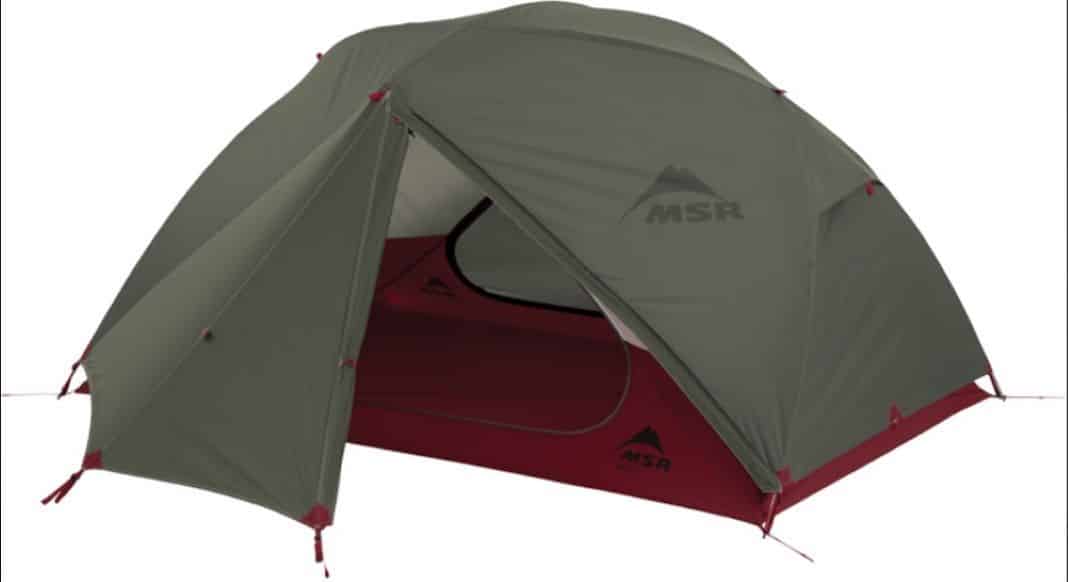
Weight: 2.77kg
Pack size: 51 x 17 cm
Water column (outer tent, floor): 1,500mm, 3000mm
Features: since 2018 with more space
The Elixir is one of MSR’s newest tents. The space is intended for 2 people. MSR officially promotes the Elixir 2 as a backpacking tent. This results in a great advantage: the tent has particularly large vestibules on both sides. They’re actually for backpacks. Large bike bags and equipment fit of course just as well underneath 😉 the weight is 2.7 kilos. As a tent for a normal bike tour, the weight is therefore perfectly fine and the equipment is just right for a tour for two.
The price of the MSR Elixir 2 is particularly interesting for a high-quality brand tent: the tent costs just over 200€ at well-known online retailers.
MSR Hubba Hubba NX
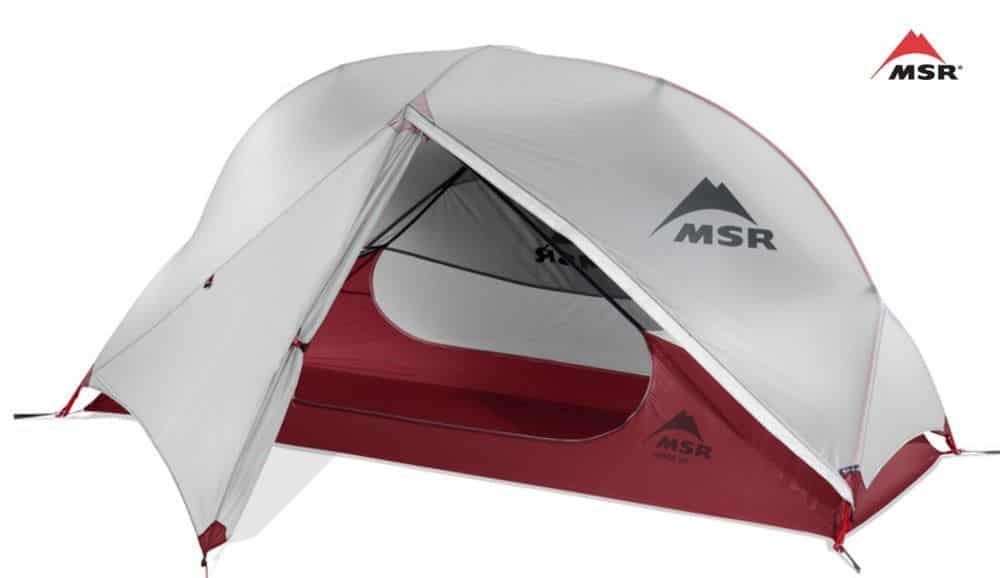
Weight: 1.72 kg
Pack size: 46 x 15 cm
Water column (outer tent, floor): 1200, 3000mm
Features:
The MSR Hubba Hubba NX is one of the most popular tents for bike travel and is also great for a bike tour. There are also many bicycle travellers who tour the world with a tent. The tent has also been my favorite bikepacking tent for a few years now. Here you can find my extensive MSR Hubba NX field test. The popularity of the MSR Hubba NX has several reasons:
The MSR Hubba Hubba NX is lightweight yet very durable. MSR has continued to develop and improve the tent over the years. There are also two colors: white and green. In order to remain undetected when wild camping, I bought the green version myself.
In the MSR Hubba series there are different tents for different requirements:
- The Hubba NX is the ideal bikepacking tent – because it weighs only 1.12 kg.
- The Hubba Hubba NX offers plenty of space for a solo bike traveller: With 2 vestibules, there is also plenty of space in front of the tent for gear
- For a couple on a bike tour, the Mutha Hubba NX is the ideal tent for the bike tour: it also weighs only 2.3 kg
Change Pathfinder TL
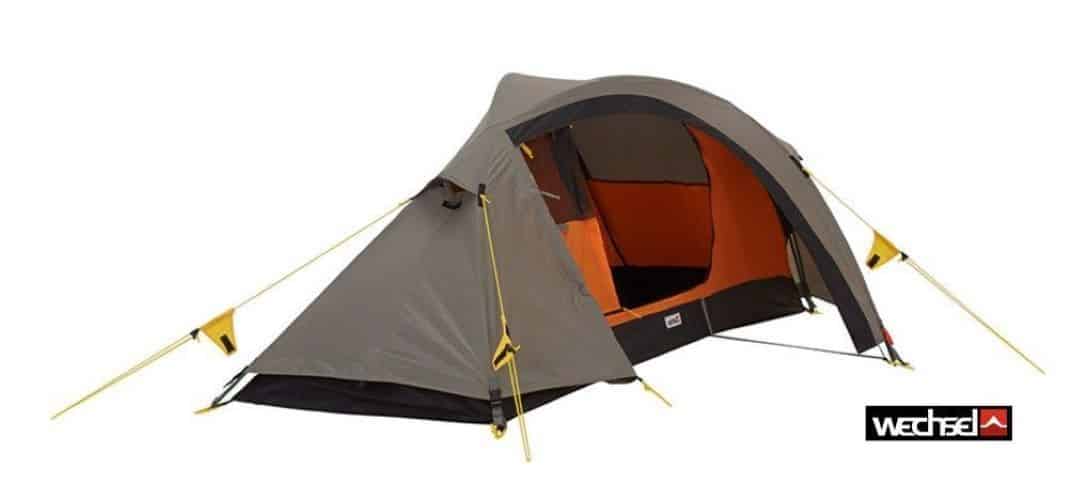
Weight: 2.3kg
Pack size: 45 x 15 cm
Water column (fly, groundsheet): 5000mm, 7000mm
Features: suitable for tall people
The Wechsel Pathfinder is a 1-person tent with extra space. The Pathfinder weighs only 2.3 kg – that’s light for the „tent for bike touring“ category. So what does the tent offer? With a length of 2.35 in the inner tent, the Wechsel Pathfinder is especially suitable for tall people. The water column is 5000mm for the outer tent and 7000mm for the tent floor. The height of 75cm is rather low, but with a maximum width of 94cm the tent offers a lot of space for equipment inside. The tent is also free-standing: a great gain in comfort that also saves time during pitching and dismantling.
The price of the Wechsel Pathfinder is unbeatable and therefore the tent is the price tip in this category.
Salewa Denali II
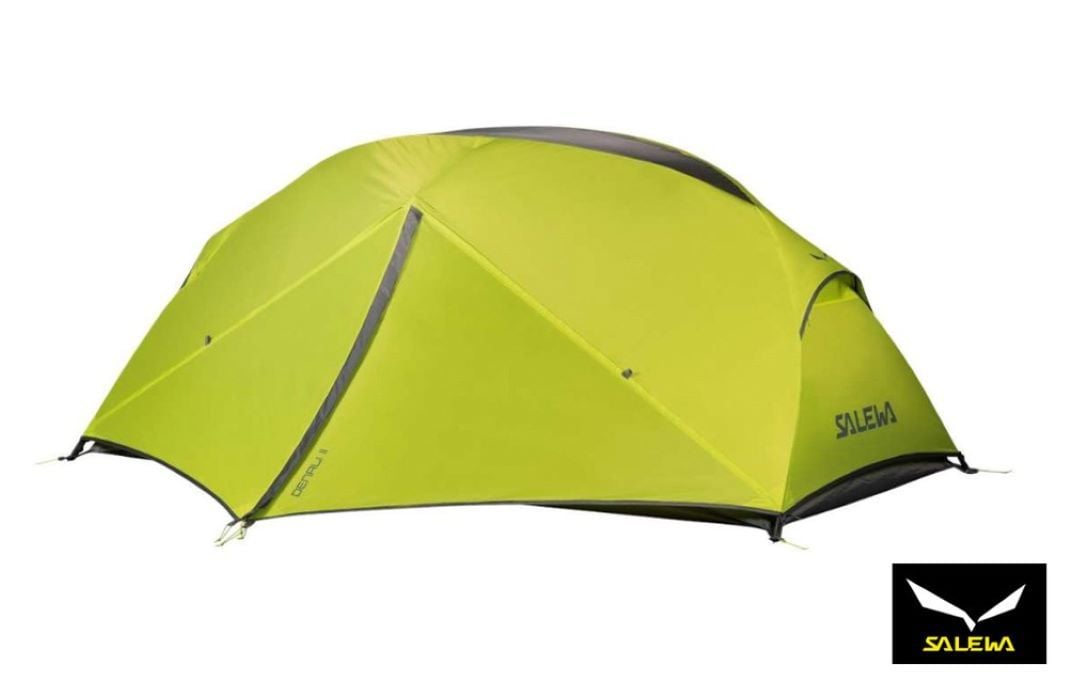
Weight: 2.63kg
Pack size: 47 x 20cm
Water column (fly, groundsheet): 3000mm, 5000mm
Features: Self Standing, Classic
Salewa is a traditional tent builder and brings a lot of experience to the table. The company is known for very good tents. On the one hand, the Salewa tents offer high quality – but are also somewhat heavier.
The Salewa Denali II is nevertheless an attractive tent: it is free-standing, weighs 2.63 kg and is very attractively priced. Thus, the Salewa Denali II is definitely an interesting tent. Especially if you are looking for a reliable tent for a longer bike trip.
The technical data is convincing: The space inside is ample and very comfortable, especially for one person. The length of the lying surface is 2.10 meters. At 1.10 metres in width, there is plenty of room to lie down and carry extra equipment. The seat height is a comfortable 1.05 metres. So you can stay in the tent even longer in bad weather.
I don’t think the yellow colour is ideal: it only attracts unnecessary attention when wild camping.
Nordisk Finnmark 2 SE

Weight: 3.0kg
Pack size: 15 x 50 cm
Water column: 3000mm, 10000mm
Features:
With the Nordisk you really get a lot of tent for the money: It is a 2-person tent and offers 1.15 metres seat height, 1.50 metres width and 2.30 metres length for the lying area. The ideal tent if you are going on a bike tour as a couple and want a bit more space.
The weight of 3 kg is a good value for a tent with such ample space. As I said, a great tent for those who want a little more space.
Bikepacking tent – the TOP 8
These are the most interesting bikepacking tents. No bikepacking tent on this list weighs more than 1.23 kilos and the lightest comes in at a featherweight 798 grams. Exceptions are the price tips. Here the weight is a little higher. It is often astonishing how resistant the tents are despite their lightweight construction.
A good entry-level bikepacking tent is also available for really cheap. For several hundred euros you get tents from the top class. Many of these tents are designed specifically for bikepackers or have a good reputation in the bikepacking community.
Some of the tents recommended in the list above (tent for bike trip and tent for bike tour) I mention here again. These are then mostly weight-reduced versions of the upper tents or it is simply the 1-person tent instead of the 2- or 3-person version.
Overview – Bikepacking Tent
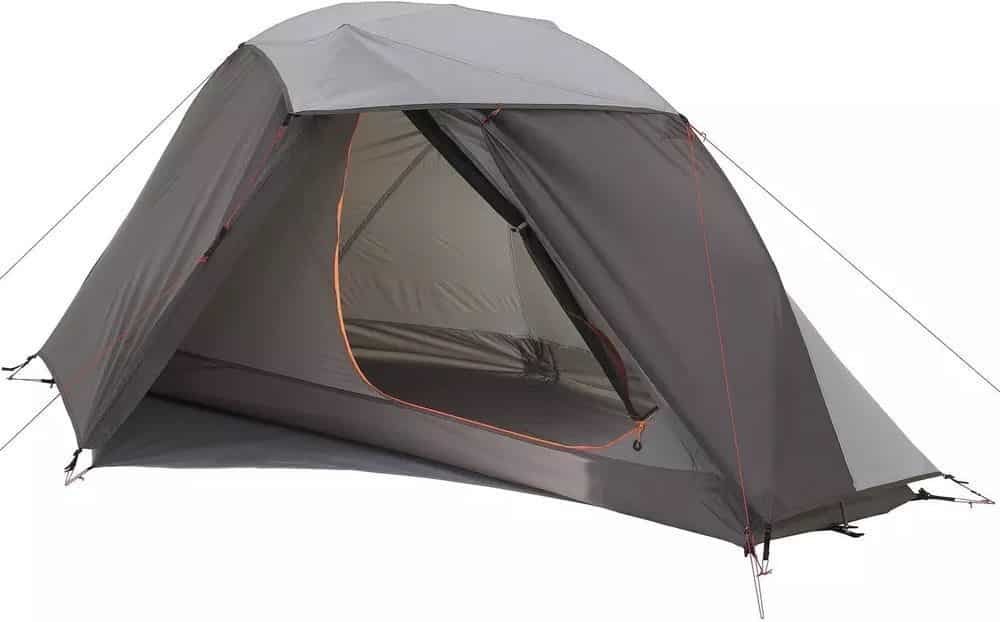









* Werbung - Aktualisierung am 2025-07-11, Preis kann gestiegen sein, Als Amazon-Partner verdiene ich an qualifizierten Verkäufen, Bild:Amazon
MSR Hubba NX

Weight: 1.12 kg
Pack size: 46 x 15 cm
Water column: 1200, 3000mm
Features: 3 seasons
The Hubba NX is MSR’s best-selling 1-person tent. This tent has been my absolute favorite for several years and I’ll tell you why right now. Before that, a quick note: The Hubba NX is also available as a 2-person tent and is then called Hubba Hubba NX. In any case, I am not the only one who is convinced of the tent: Many cyclists have already made world tours with these tents.
The tent is a 3-season tent and weighs just 1,120 grams complete with all the trimmings. Say: The tent, all the poles and the pegs. A Footprint thus a ground protection tarpaulin I recommend to buy in any case still in addition. However, this only comes to a few grams.
The tent is free-standing and can therefore be erected without tensioning. It is still stable in up to medium-strong winds. If the wind then becomes very strong, the tent should be braced. The ventilation is excellent and also the weather resistance I can confirm: Even in heavy rain, water never came through the tent wall or even the tent floor.
The seat height is 90 centimetres and the reclining width is 76 centimetres. To illustrate: With my 1.84 meters I lie quite relaxed and stretched out in the tent and still have room and a small backpack to accommodate. The rest of the luggage then goes under the vestibule. Check out my extensive MSR Hubba NX field test for even more details on this top bikepacking tent.
The tent was simply very well thought out by MSR: The MSR Hubba NX is a really good tent with many strengths and no real weaknesses.
The MSR Hubba NX is definitely worth the price.
To the detailed MSR Hubba NX field test (test & experiences)
MSR Carbon Reflex
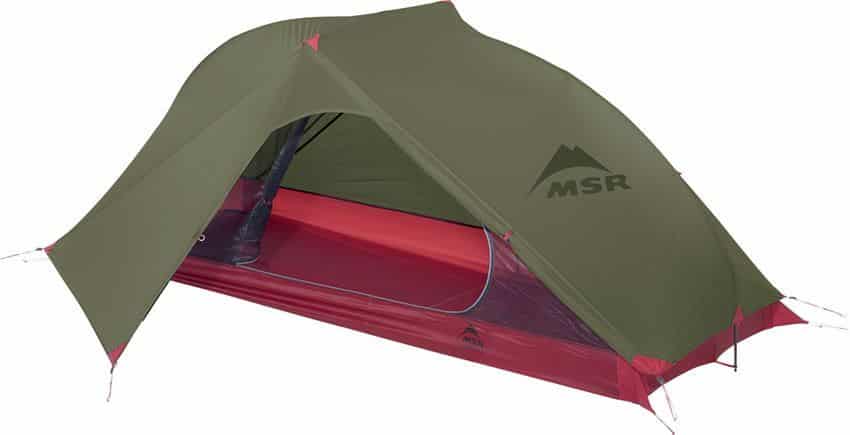
Weight: 798 grams
Pack size: 43 x 13 cm
Water column: 1200, 1200mm
Features: 1 person, 1 entrance & vestibule, UL 7D fabric.
At just 798 grams, the MSR Carbon Reflex 2 is significantly lighter than the Hubba NX. It’s also MSR’s lightest, double-walled tent. To achieve the weight, MSR has used quite thin material: 7D fine material is used for the outer tent. The floor is made of 15D Ripstop Nylon, a slightly stronger material. although the outer tent as well as the floor have a water column of 1200.
There is no zipper at the entrance. A velcro fastener and two hooks are used. Very weight-optimized. The head height of 81 cm is low, as expected. Experience shows that the carbon frame is one of the weak points of the tent.
Naturehike New Cloud Upgrade
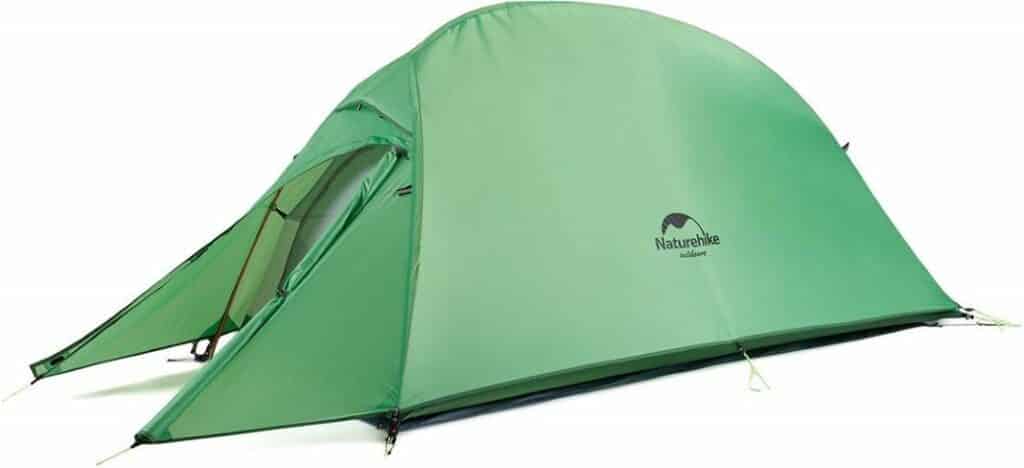
Weight: 1,550 grams
Pack size: 45 cm x 12 cm
Water column: 3000, 3000mm
Features: 1 person, 1 entrance & Apside
Probably the most popular replica of the MSR Hubba NX is the „Naturehike New Cloud-Up“ or also „Naturehike Cloud-Up upgraded“. The Chinese company has done a really good job here:
For just over 100€ you get a reliable tent with very similar features: The weight is with 1,550 grams about 250 grams heavier than the MSR tent. Otherwise, the workmanship of the zippers is not quite up to the original.
Of course, the Cloud-Up is also freestanding, but you have to unhitch it a little earlier than the MSR Hubba NX. Very pleasing: The high water column of 4000mm for the tent floor and the outer tent. In addition, the scope of delivery also includes a footprint.
The buyers on Amazon seem to be very satisfied with the tent. I have also seen the tent live once at friends and could convince myself of the quality. Definitely a price-performance tip.
Naturehike Neues Cloud-Up Upgraded auf Amazon kaufen*
Decathlon Forclaz Trek 900 Ultralight

Weight: 798 grams
Pack size: 40 x 12 cm
Water column: 4000, 5000mm
Features: 1 person, 1 entrance & vestibule, UL 7D fabric.
The Decathlon Trek 900 is another price tip in the bikepacking tent category. The Trek 900 can be bought online at Decathlon for about 120€.
For the price, the Decathlon Trek 900 offers a surprising amount of advantages and has hardly any weaknesses. In principle, it is largely a replica of the excellent MSR Hubba NX.
With a weight of about 1,600 grams, the tent is about 200 grams heavier than the MSR Hubba NX, which is more than twice as expensive. The packing dimensions are 40x12x12 and are absolutely fine.
For a lightest bikepaking tent for one person, you can also be comfortable inside: 95 cm high. Inside you have 60 centimetres of space on the head side and 50 centimetres on the foot side. As usual with a lightweight tent, the sides are not exactly spacious. You should still be able to fit some gear in the tent. If the space requirement is larger then the tent also has a vestibule.
Fortunately, a footprint and a repair kit are included in the delivery.
To the detailed Forclaz Trek 900 Ultralight practical test (test & experiences)
Vango F10 Helium UL 1
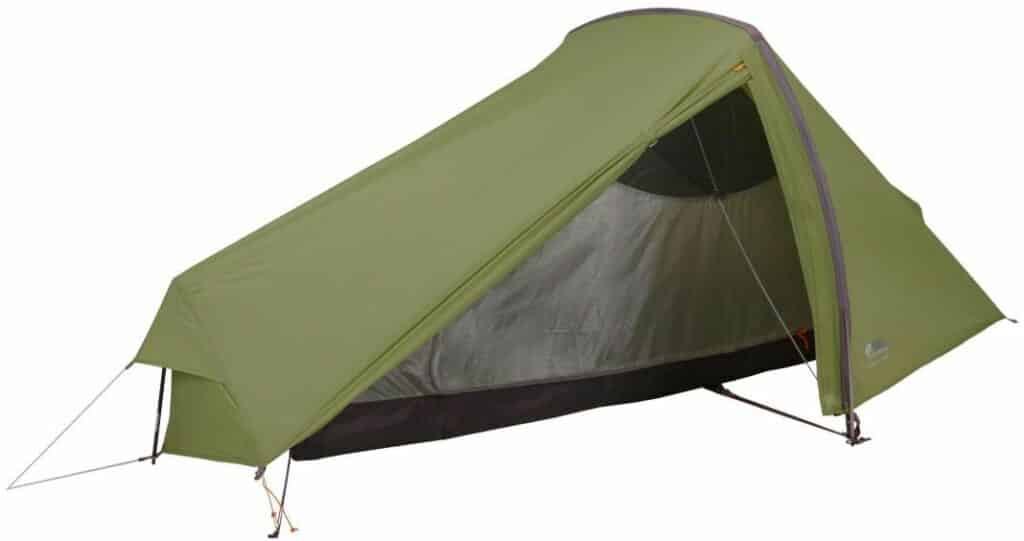
Weight: 1.23 kg
Pack size: 43cm x 9cm
Water column: 3000mm outer tent, 6000mm floor
Features: 1 person, 1 entrance & vestibule, UL 7D fabric.
The Vango F10 Helium has almost all the features you could want in a bikepacking tent. The price remains pleasantly low. Good reasons, therefore, to take a close look at the tent:
The Vango F10 Helium offers extra head and legroom. The outer tent is made of 15D nylon. The base plate is made of particularly robust 70D nylon. This also results in a high water column of 6000mm for both the outer tent and the tent floor – in addition, all seams are factory-taped and therefore waterproof. A footprint is not included, but can be purchased as an accessory.
The interior dimensions promise great space for a 1-person tent. There is space for equipment on both sides: on one side, a triangular area has been added to the inner tent for storage space. There is an apse on the other side.
Big Agnes Fly Creek HV UL1

Weight: 0.98 kg
Pack size: 48 x 10cm
Water column: 1200, 1200mm
Features: super light, 3 seasons.
Big Agnes is especially popular with bikepackers and backpackers in the USA. The most popular models are now also available from us. Anyway, there is a whole range of interesting tents from Big Agnes. These combine light weight with a pleasantly large amount of space. Ideal bikepacking tent therefore.
To be sure, the Fly Creek is not completely freestanding. On the other hand, it is particularly light with a total weight of 980 grams. We are dealing with a 1 person and 3 season tent here. The price of about 330 euros is also very fair for what is offered.
There are also 2- and 3-person models of the Big Agnes Fly Creek HV. The 3-person model is still pleasantly light at 1.5 kilos. It is therefore particularly suitable for cyclists with a large space requirement, who nevertheless attach importance to a lightweight tent.
By the way, the addition HV in the product name indicates the revised version of the Big Agnes Fly Creek. In the new HV model, the tent walls have been pulled up more steeply. This makes better use of the indoor space.
Big Agnes Copper Spur HV UL1
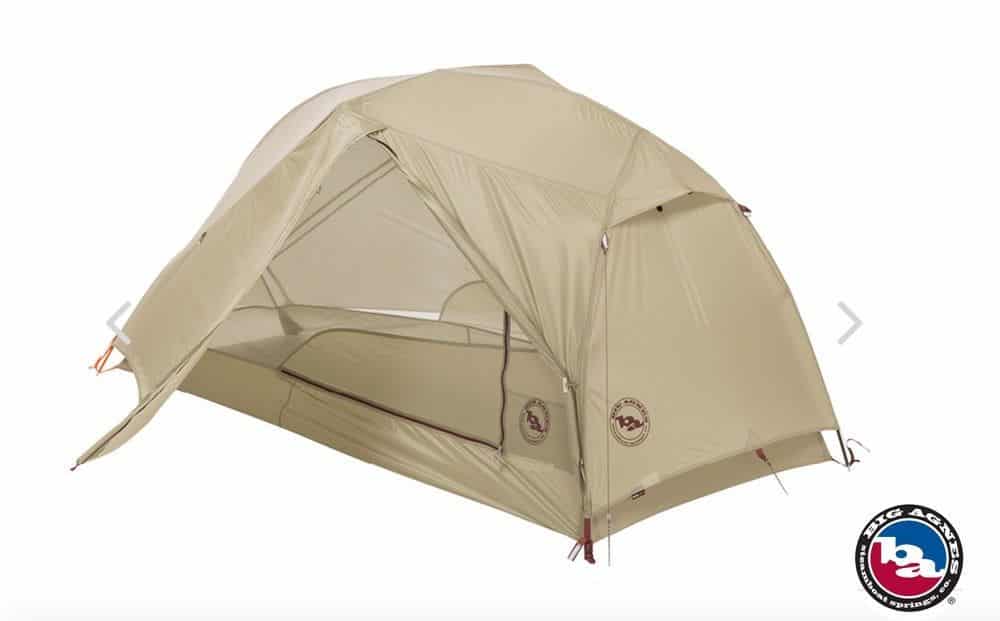
Weight: 1.13 kg
Pack size: 42 x 10cm
Water column: 1200mm, 1200mm
Features: very light, 3 seasons.
Another Big Agnes tent in the bikepacking tent category. Compared to the Fly Creek, the Copper Spur is completely freestanding. With a total weight of 1.5 kilos, the tent is still pleasantly light.
As is often the case with freestanding tents: With the Copper Spur, the inner tent can be pitched independently of the outer tent. This optimises ventilation and the view on hot summer nights. Or the outer tent is used as a tarp without the inner tent to save a few more grams. Can also be used for
There is also a 2-person and a 3-person model of the Copper Spur. The weight is then still absolutely within the framework and the space is of course comfortably large.
The same applies to the Copper Spur: the HV suffix in the name identifies the revised version of the bikepacking tent. The tent walls rise more steeply, which increases the space available in the interior.
Nordisk Telemark 2 ULW
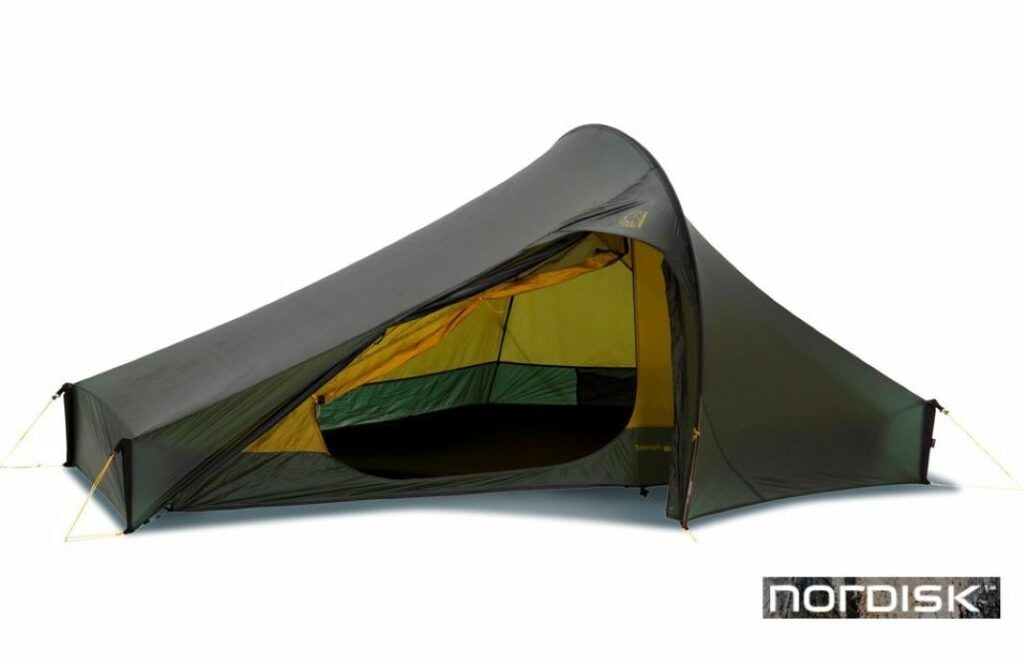
Weight: 0.88 kg
Pack size: 41 x 12 cm
Water column: 2000mm, 2000mm
Features: received multiple awards & Design Award
The Nordisk Telemark 2 ULW has received several awards for its special design. It’s also incredibly lightweight at just 880 grams. For a double-walled tent, that’s a house number. Officially, the Nordisk Telemark 2 ULW is a 2-person tent. However, I recommend using it for only one person.
Then you can also be pleased about the large amount of space: Luxurious 1 metre seat height and 1.02 lying width are offered. Thus also still another some equipment in the tent comes under.
At around 600 euros, the bikepacking tent is not exactly cheap. If you’re looking for a tent that’s both high-quality and lightweight, you should definitely check out the Nordisk Telemark 2 ULW.
Ultralight tent – The TOP 5
Follows 😉
Overview – Ultralight Tent
Follows
Guide – Tent for bike travel and bikepacking tent
So by now you know what you need your tent for and I have introduced you to the most suitable tents currently available. In this guide, we delve deeper into the topic of bikepacking tents and tents for bike touring.
Important questions before buying a tent
Some important aspects should be considered before buying a bikepacking tent and a tent for bike travel. Let’s get the main points straight. I also give my own practical experience on each point.
Single and double-walled – the type of construction
A single-wall tent, as the name implies, consists of one wall. In such a tent you are less well protected from the weather, insects and dirt. You can also come into direct contact with condensation on the tent wall.
A double-walled tent offers many advantages in comparison: The outer tent provides weather protection and ventilation. The inner tent offers protection from insects, the weather and dirt. In addition, one is much better protected from condensation inside.
In comparison, a double-walled tent therefore offers many advantages. In return, it is about 200 grams heavier. You also lose about 5 inches to each side through the inner tent. In summary, a multi-wall tent offers many clear advantages. Most travelers can certainly get over the slightly higher weight. For most cyclists, therefore, a double-walled tent is probably the best choice. Only if every gram is important, a single wall tent could be an alternative.
With many tents, the inner tent and outer tent can be pitched and packed separately. This opens up many possibilities:
- Building the outer tent without inner tent: Opportunities especially in dry areas without insects. You save weight and have more space.
- Pitching the inner tent without the outer tent: Recommended in Hot regions, indoors, under canopies or even indoors. The inner tent serves as mosquito protection. In addition, one has a better ventilation which can be especially pleasant in hot areas. The view of the starry sky is also free.
- In the event of rain, pack and transport the wet outer tent separately from the dry inner tent.
Type of guy: freestanding or guyed?
Some tents are free-standing, i.e. you do not have to tie them down with a peg. They stand by the tension of the tent poles alone. For even more stability, these tents can be additionally braced with tent cords and pegs. Dome tents and geo tents are representatives of the freestanding category.
Note should be taken: On stony ground or if the ground is too soft or too hard, then no herring holds. Nor indoors. In such a case, a free-standing tent is worth its weight in gold. In addition, you don’t have to unpeg the tent, saving you time and effort.
Free-standing tents are also usually quicker to erect than non-free-standing tents. Especially in rainy weather and at the end of an exhausting day an uncomplicated tent has advantages.
Free-standing tents are usually about 200 grams heavier than non-free-standing tents.
Weight
The ideal tent should weigh as little as possible. When you carry less weight on your bike, you move faster and easier – and riding is more fun. At the latest when you have to push or carry the bike, you know what I mean.
Modern tents can be incredibly light. So the best tent for a bike trip should be as light as possible. This is especially true for bikepackers.
Pack size
The ideal tent for bike trips should have the smallest possible pack size. Then it takes up less space in the bike bags. The sticking point when it comes to tent packing dimensions are often the tent poles: These are the longest items. Unfortunately, especially free-standing tents often have somewhat longer tent poles. This is usually not a problem on a bike trip: The tent poles are then simply fastened securely in the middle of the luggage rack.
Thanks to its small pack size, the ideal bikepacking tent fits in the handlebar roll or in the frame bag. Some manufacturers now sell special bikepacking versions of their tried-and-tested tents: these feature particularly short tent poles, making them ideal for stowing in the handlebar pulley or frame bag.
Durability
The longer your bike trip, the more important the durability of a tent. But also in general you want to have a long time pleasure with your purchase. Modern lightweight tents have a limited lifespan. So on a really long bike ride, strictly speaking, you could talk about a consumable. I’m sure many long-term travellers had a number of tents in use at once on their trip. There is a whole series of common sources of faults: zips no longer work, the underbody is less and less waterproof or the tent poles break after a certain time. UV rays also damage the outer tent over time.
Stability
Can your bikepacking tent withstand stormy weather? Stormy weather is the exception rather than the norm. However, if the cycling trip lasts for a long time, it can sometimes come to a thunderstorm or squalls. Some regions are also known for particularly unpredictable and harsh weather – for example Iceland.
So the ideal tent should be able to withstand a storm. Even if houses, animals or even cars are blown away in the surrounding area 😉
Two factors significantly influence the stability of a tent: the type of tent and often also the weight.
- Influence of tent design on stability: Geodesic and tunnel tents are particularly stable in windy weather. Always provided they are correctly braced. The direction in which the tent is pitched also plays a role: the tent should be pitched in such a way as to give the wind as little of an attack surface as possible. Ridge tents, which are wedge-shaped tents, are most susceptible to strong gusts of wind. Nowadays, however, tents of this design have largely been superseded by other designs. More about this also further down in this article
- Influence of the tent weight on the stability: Basically, a very light or even a UL tent (Ultralight tent) is often not as storm-proof as a slightly heavier one. As described above, some tents do not need to be braced. These are then so-called free-standing tents. The additional support provided by the pegs in the ground and the guy ropes naturally increases the weather and wind resistance.
In the event of a storm, it is then also worthwhile to unhitch this tent.
Interior space
In the ideal tent there is enough space for more than just a sleeping mat. In the ideal tent, people sleep, unpack and repack travel gear, work, play, change clothes and invite guests.
A tent for a bike trip usually provides space for the sleeping pad and the bike bags.
In a bikepacking tent there is usually room for a small backpack or saddle bag in addition to the sleeping pad. In a very minimalist Ultralight tent there is usually only room for the sleeping pad.
Vestibule – space outside
The best tent for bike touring and bikepacking also has room to keep gear safe and dry. The bike has to stay outside most of the time for space reasons. But even quite small tents usually have a vestibule, i.e. an awning. Larger tents sometimes even have two of them. Additional equipment such as panniers can be stored there. The vestibule is also an ideal place to put your shoes or cook.
With many modern tents, the size of the vestibule can be changed by bracing it accordingly. If the vestibule is correctly tensioned, the equipment will usually only get a few splashes, even in moderately heavy rain.
Color and visibility
The tent color is not only a matter of personal taste. If you would like to go wild camping, for example, then you should remain undetected. An inconspicuous tent color helps a lot. A tent that adapts to its surroundings, almost like a chameleon, is therefore ideally suited.
For the following cases, different colors have proven to be useful:
- Dark green, dark brown and neutral colors: The tent is particularly inconspicuous in nature and you will not be seen immediately.
- Red, light brown, bright orange colors and yellow: The tent is more suitable for the high mountains. Here the tent can be discovered quickly. In dangerous situations such as avalanches or for orientation, this feature can save lives. In desert regions these colors are very inconspicuous.
The choice of colour therefore depends entirely on the environment in which you intend to use the tent most of the time.
Weather resistance
A good tent keeps you dry inside and stays tight even in the rain. The best tents will do that even in monsoon-like rain or if they get washed out. Could you get into a weather situation like this? You should think about this before your bike trip.
The following measures can increase the weather resistance of a tent:
- Footprint: A footprint is available as an accessory for most tents. Sometimes this ground cover is already included in the delivery. The Footprint increases the water resistance of the tent floor and protects it from wear and tear. For some tents there are special large groundsheets. In addition to the tent floor, these also protect the space in the awning so that the equipment in the awning also stays dry.
- Adaptable outer tent: With flexible tents, the outer tent can be pulled down low. Also, the outer tent should generally reach all the way down at the corners. This will keep rain splashes out safely. The side walls can then be left up in good weather and allow pleasant air circulation.
Ventilation
Comfortable ventilation is one of the most important aspects when buying a tent for bike touring and for a bikepacking tent. In the worst case, a large amount of condensation can collect on the tent wall. So much that water drips down and literally makes you wet! Tents with poor ventilation also heat up quickly, even in the early morning.
The following points ensure particularly good ventilation in the tent:
- Double-walled tent: Due to sweating and breathing, condensation forms on the outer tent. With a single-wall tent, you can easily touch the tent wall. In addition, the condensation water can also drip downwards. An inner tent prevents condensation from touching the tent and sometimes keeps water from dripping down.
- Adjustable outer tent: The ventilation of the outer tent should be adjustable. Basically, raised exterior walls provide better ventilation. In the event of bad weather, the outer tent can then be pulled lower for rain protection.
- High mesh content in the inner tent: Large areas of sewn fly netting promote ventilation in the inner tent. In hot weather, only the inner tent can be pitched (without the outer tent). Then a pleasant breeze can blow through the tent. You can also marvel at the starry sky at night.
Privacy in the tent
After a long day on the bike, you’ll probably want to retire for a while. In the ideal tent you should therefore feel safe and secure. Especially in hot weather, the following point can be important: For ideal ventilation, you can only pitch the inner tent without the outer tent. Then you can be pampered by a warm breeze. Not everyone should look directly into your tent? Then an inner tent with a combination of mesh and solid tent makes sense. An inner tent completely made of mesh is very easy to see from the outside.
View from the tent
Your tent should protect you from rain and bad weather. But thou shalt not suffer from claustrophobia in it! But when the weather and nature are at their best, you want to soak it up 🙂 Right out of your tent! For a particularly beautiful view out of the tent: a retractable vestibule (awning) and a fly net (mesh) on the tent door or a high mesh section on the inner tent.
Costs
Of course, price is also an important factor when buying a tent! How much tent do you get for your money? Really good tents from well-known outdoor brands cost several hundred euros and are definitely worth the money. However, it is understandable that many people have a price ceiling for buying a tent.
The good news in this case: There are also some good alternatives for just over a hundred euros. In the core, the weight of these tents is then usually a few hundred grams higher. However, compared to the top tents, they cost only about half. I realize that price is an important factor. That’s why I’ve included these inexpensive alternatives above.
What types of tents are there?
In this section I explain in detail the different tent designs. I’ll also list the pros and cons for you, and then give a conclusion on tent construction.
The following designs are possible for a tent for bike touring and a bikepacking tent
Ridge tent
The ridge tent is a very simple tent design. It is built in a wedge shape and the tent walls slope steeply towards the outside.
advantages and disadvantages
✅ Special lightweight construction: This construction can be a few hundred grams lighter than other types of tents. There are therefore some UL tents in the ridge tent design.
❌ Steeply sloping tent walls: This also severely limits the space inside.
Because of this disadvantage, ridge tents are only the exception nowadays. This design was superseded by other designs.
Tunnel tent
As the name suggests, these tents look very similar to a tunnel. The tent poles are almost perpendicular to the ground when the tent is erected. This results in the following properties:
advantages and disadvantages
✅ Good ratio between floor space and available space as well as seat height
Comparatively large vestibule due to the tunnel construction, especially an advantage in comparison with dome tents.
✅ very good space-to-weight ratio
❌ Unfavorable much attack surface for wind and squalls. To minimise the area of attack, the tent should be aligned lengthwise to the wind.
❌ Not free-standing: Must be braced
Dome tent
The walls of the dome tent are almost as steep as those of the tunnel tent. This results in a number of interesting properties
advantages and disadvantages
✅ Good ratio between floor space and space available as well as seat height – but somewhat worse than the tunnel tent
✅ good space-to-weight ratio – here also somewhat worse than a tunnel tent
✅ Free-standing: Stands without guy ropes and pegs
✅ Resistant to wind gusts and storms
Geodätzelt
The geo tent is a complex tent construction, suitable for 2 persons and more and offers a number of unique advantages. If the tent has to be particularly robust, then the geo tent can be a good choice.
advantages and disadvantages
✅ Also good ratio between floor space and space available – similar to dome tent
✅ Very robust against wind and storm: Due to the multiple crossed pole construction
✅ Carries snow loads well
✅ Free-standing: Stands without guy ropes or pegs
❌ Complex under construction: Requires at least 2 people
Bivouac tent
Take a bivy sack, add a mini tent to the head end and the bivy tent is ready. Due to the limited space, as well as low comfort, the Biwack tent is a niche product. For a short bikepacking trip, the bivy tent can be an alternative to a bivy sack or a 1-person tent.
Advantages and disadvantages of the Biwack tent
✅ Unbeatable light tent
✅ Unbeatable small tent pack size
❌ Low comfort
❌ Hardly any space: Can only be used for sleeping
Throw tent
A roll-up tent is more suitable for weekend trips by car. I mention this design therefore only for the sake of completeness. The poles are integrated into the tent. The tent practically pops up by itself when it is opened. Thus it stands within a few seconds and is also quickly packed again.
However, due to its construction, the packed tent is very heavy and large. This makes it unsuitable as a tent for bike touring and certainly not as a bikepacking tent. A throw tent is also not wind and weather resistant. Tents of this type are therefore more often found at festivals.
Conclusion – Tent construction
At the beginning of this article we clarified your requirements for a tent. Then we took a close look at the most important features when buying a tent. Now you know the advantages and disadvantages of the different types of tents. So match your requirements with the features of the tent builders and then make a buying decision.
The tents presented in this article can also help you decide. Do you have any questions or suggestions for additions? Then feel free to write me a comment 🙂
Ultralight sleeping pad test & comparison – find your next featherweight companion for trekking, bikepacking and all other outdoor adventures. Great overview and practical test
Wild camping in Europe – where is it legal and where is it illegal? In this article you will find the complete overview with all countries



